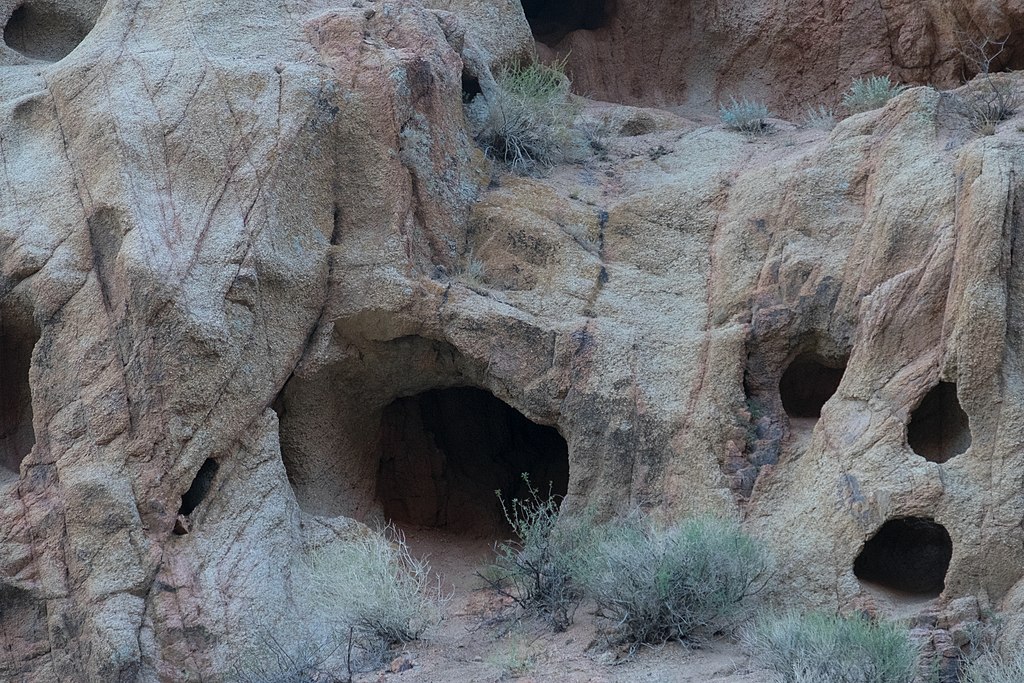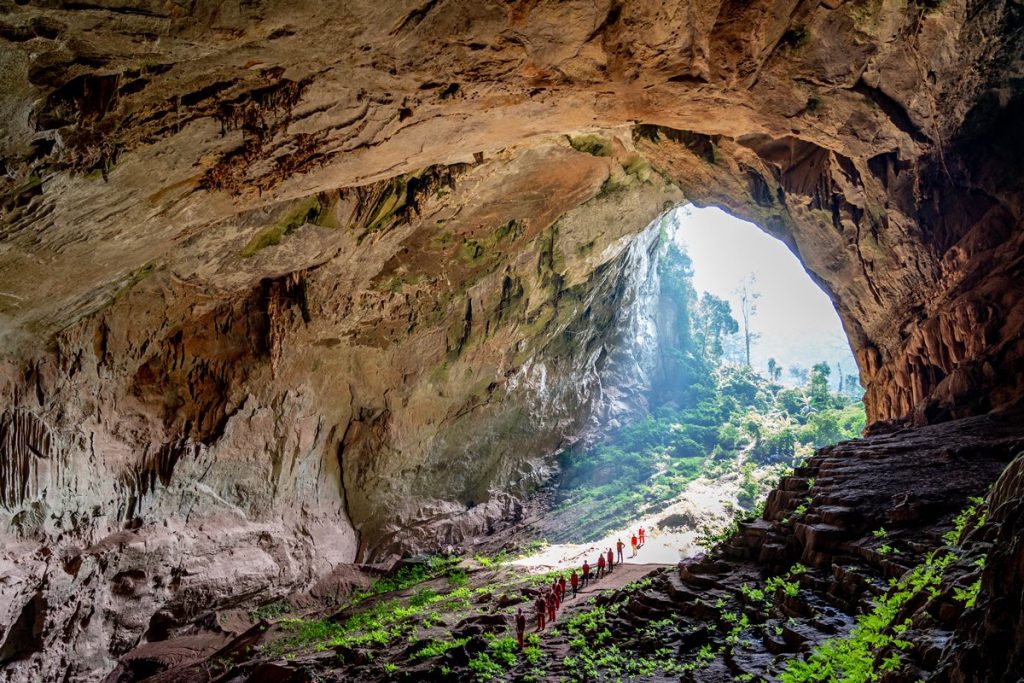Beware: You should never explore wild caves alone or without proper gear. Consider getting in touch with a Grotto of the National Speleological Society at www.caves.org or a qualified cave club. These groups are skilled and will train you. Without sufficient knowledge, preparation, and equipment, cave exploring can lead to serious injury or death.
One question our explorers often have is regarding the myriad types of caves they may have seen in pictures or visited themselves. Some caves contain ice. Others are underwater. How do we classify them all?
Caves are natural formations that carve out passages in the earth, often forming intricate shapes with high ceilings and narrow passageways. Different caves form through different processes.
For example, suppose there is limestone present. In that case, the cave will most likely contain dozens or hundreds of stalactites and stalagmites. These form from limestone deposits, made from calcium carbonate, which have dissolved into liquid form over time. The rainwater runoff initiates this process, which happens very slowly.
Sedimentary rocks (i.e., marble) form when marine organisms and organic matter settle on the ocean floor and compact into sediment over time. These rocks become exposed by tectonic uplifting or erosion of surrounding landforms as mountains or river valleys.
Volcanic lava can cool quickly and form dikes, sills, and other types of rock bodies which will eventually become caves if they remain undisturbed by erosion. In some cases, especially in limestone regions where karst formation is standard.
How Different Types of Caves Form
Caves can be found in many places worldwide, including deserts and mountains. The type of soil or rock a den is located in determines the kind of cave it will be. But how do they come to be?
Caves may form in the process known as “solutional (or chemical) weathering,” whereby rising groundwater dissolves rock over a long period.
However, this process usually happens at a prolonged rate unless there are drastic changes, such as earthquakes or other significant disturbances that cause rapid movement of ground water through a geologic fault zone (a place where two different types of bedrock meet).
1) Glacier Caves
Glacier caves are formed by, you guessed it, glaciers. These caves can be found in the mountains and are usually very big.
They also sometimes appear in cold places where the temperature is low enough, such as Antarctica and the Arctic regions of North America and Europe.
When glaciers flow down mountain valleys and melt at the base of their formation, glacier caves form.
The water from melting ice flows through rock cracks, creating underground passages. When these passages widen enough, they become caves.
Glacier caves have smooth, rounded walls and often contain nothing but ice. The ice may be transparent or tinted white, depending on how much air is trapped inside. These caves are also “glacial tubes” or “ice caves.”

2) Solution Caves
The second type of cave, solution caves, forms when water dissolves limestone. Solution caves are found in rocks but are most common in limestone. The resulting features include stalactites (stalagmites under the ground) and columns.
Some solution caves resulted from the eruption of volcanoes. If there was a large amount of lava flow, it could have carried minerals that would precipitate out as the surface cooled and hardened to form crystal-lined walls and ceilings.
Other significant deposits that can form include gypsum (calcium sulphate) and salt beds formed from dried-up lakes or seas left behind when they receded from land masses during glacial periods.

3) Talus Caves
If you’re looking for a place to take shelter, consider a talus cave. These natural formations are formed by the talus slope, a sloping rock pile, and boulders.
The rocks and boulders that fall from above drive down the slope, resulting in caves formed by the constant pressure of falling debris.
As water seeps into the cracks between these rocks, it soon forms an underground chamber with a vaulted ceiling and walls that can be several feet thick.
Talus caves are a great place to find shelter from the cold during the winter months. However, they’re often occupied by bats and other animals during warmer seasons, so you’ll want to be careful when entering them.

4) Sea Caves
If you have ever been to the coast and walked along the shoreline, you may have noticed holes and crevices in some rock formations. These holes and crevices become sea caves.
They occur when waves break on a sandy or rocky shoreline. The force of these waves causes pieces of rock to fall off the cliff face, leaving open spaces behind them.
Over time, these openings become more extensive as more pieces fall away or collapse altogether.
As erosion continues, sea caves can eventually be formed in areas where water levels are shallow enough for waves to reach their full potential without hitting obstructions—typically less than 100 feet (30 meters) deep at low tide.
The tops of many sea caves are covered with seaweed or other organic material that has washed up onto them over time; this gives them an appearance similar to an old boot filled with sand.

Note that sea caves are still above water, earning the name littoral. They allow cavers to travel inside on a boat, without needing to worry about diving gear. But underwater caves exist as well, and those often require a professional guide and adequate equipment. You can see some of the most popular underwater caves here.
5) Lava Caves
Lava caves form when lava flows through a cave, leaving behind a tube. These appear in volcanic areas like Hawaii and the Canary Islands.
The tubes are usually several miles long and often have high ceilings – up to 100 feet tall! The walls of lava tubes are smooth from the molten rock flowing over them and down into the cave’s floor.
The inside of a lava tube may be as hot as 700 degrees Fahrenheit (about 400 degrees Celsius), but because it’s so large compared to other caves, explorers don’t need special gear or clothing to safely explore this type of cave system.
Lava tubes are hazardous because they can collapse without warning. In Hawaii, several people have died from falling into lava tubes or being hit by falling rocks.
Lava tubes are also prone to earthquakes that can cause them to collapse or break open in new places.

6) Eolian Caves
Eolian (sometimes spelled aeolian) caves form primarily by wind-blown sand. These caves are uncommon, found only in deserts and other arid areas, where the wind can scour out depressions in the rock.
Eolian caves also form in areas with little vegetation to stabilize the land surface, like deserts or polar regions.
Eolian caves form when a stream carrying sand cuts into soft bedrock along its path. Over time, this erosion causes an overhanging cliff to form above the stream bed.
When this cliff grows higher than it was initially (because of more erosion), it creates an arch under which water from rain and snowmelt flows until it reaches ground level again.

Conclusion
Caves are a significant part of our world, and there are many different kinds that we have yet to discover. While some types can be dangerous, others can offer a glimpse into the past. We gain insight into how creatures may have lived millions of years ago.
It’s easy to see how cavers experience different things based on where they take their trips. Depending on the part of the world, the weather, and the surrounding environment, there are several types of caves that can form. Some gradually form by water erosion, while others form more rapidly from lava. Still other types of erosion can create other caves, through the forces of wind and ice.
It’s a good idea to experience each of these caves at least once. We highly recommend the sea caves and glacier caves as they contain some of the most breathtaking sights nature offers.
